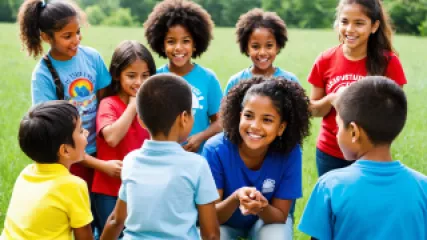How Can Parents Build Resilience in Children?
How Can Parents Build Resilience in Children?
Raising resilient children is a fundamental goal for many parents, as it equips young minds with the skills to navigate life's challenges and thrive in the face of adversity. Resilience is not merely an innate trait, but rather a collection of learnable abilities that can be nurtured and developed through intentional parenting strategies. In this comprehensive guide, we'll explore a range of practical approaches that can empower parents to cultivate resilience in their children.
Understanding Resilience in Children
Resilience, in the context of child development, can be defined as the ability to bounce back from setbacks, adapt to change, and maintain a positive outlook in the face of difficulties. Resilient children possess a range of characteristics, including emotional regulation, problem-solving skills, a sense of self-efficacy, and the ability to seek support when needed.
Building resilience in children is crucial, as it not only helps them cope with the immediate challenges they may encounter but also equips them with the tools to navigate the complexities of life in a healthy and productive manner. Resilient children are better equipped to handle stress, recover from disappointments, and maintain a positive mindset, which can have far-reaching implications for their overall well-being and success.
Nurturing a Supportive Environment
One of the foundational elements in fostering resilience in children is the creation of a nurturing and supportive environment. As Arianna Spencer, a child development expert, explains, "Children thrive in an environment where they feel safe, loved, and accepted. When parents provide a secure base, children are more likely to develop the confidence and coping skills necessary to navigate life's challenges."
To cultivate this supportive environment, parents can consider the following strategies:
- Establishing Emotional Connections: Prioritize one-on-one time with each child, engage in active listening, and validate their feelings. This helps children feel understood and valued, which can boost their self-esteem and resilience.
- Promoting Open Communication: Encourage children to express their thoughts, fears, and concerns without fear of judgment. By creating a judgment-free space, parents can help children develop the trust and confidence to share their experiences.
- Modeling Resilient Behaviors: Children often learn by observing the actions and reactions of their parents. By demonstrating resilient behaviors, such as problem-solving, emotional regulation, and perseverance, parents can inspire their children to adopt similar coping strategies.
- Fostering a Sense of Belonging: Ensure that children feel connected to their family, community, and other supportive networks. This sense of belonging can provide a crucial safety net and instill a feeling of being valued and accepted.
Developing Coping Strategies
Resilience is not solely about enduring hardship but also about having the tools to effectively manage and overcome challenges. By equipping children with a range of coping strategies, parents can empower them to navigate difficult situations with greater confidence and resourcefulness.
Some effective coping strategies that parents can teach and encourage include:
- Emotional Regulation: Help children identify and express their emotions in healthy ways, such as through journaling, art, or age-appropriate emotional regulation techniques.
- Problem-Solving Skills: Foster children's ability to break down problems, consider various solutions, and develop action plans to address challenges.
- Mindfulness and Relaxation Techniques: Introduce children to practices like deep breathing, meditation, or yoga, which can help them manage stress and maintain a calm, focused state.
- Developing a Growth Mindset: Encourage children to view challenges as opportunities for learning and growth, rather than as insurmountable obstacles.
- Seeking Social Support: Teach children the importance of reaching out to trusted friends, family members, or professionals for help and guidance when needed.
By equipping children with a diverse toolkit of coping strategies, parents can empower them to navigate life's ups and downs with resilience and adaptability.
Fostering Independence and Responsibility
Resilience is closely tied to a child's sense of autonomy and self-efficacy. By encouraging independence and the assumption of age-appropriate responsibilities, parents can help children develop the confidence and problem-solving skills necessary to tackle challenges on their own.
Some ways parents can foster independence and responsibility include:
- Providing Opportunities for Decision-Making: Allow children to make choices within clearly defined boundaries, such as selecting their own activities or contributing to household chores.
- Gradually Increasing Responsibilities: Assign children age-appropriate tasks and responsibilities, and gradually expand their role as they demonstrate competence and reliability.
- Encouraging Self-Advocacy: Teach children to speak up for their needs, express their opinions, and navigate social situations with assertiveness.
- Promoting Self-Reflection: Encourage children to reflect on their experiences, identify areas for improvement, and set personal goals for growth.
By fostering independence and responsibility, parents can help children develop a sense of control over their lives, instill a growth mindset, and cultivate the resilience necessary to overcome future challenges.
Celebrating Successes and Managing Failures
Resilience is not solely about overcoming adversity but also about celebrating achievements and learning from setbacks. Parents can play a crucial role in shaping how children perceive and respond to both successes and failures.
To support children in this regard, parents can consider the following strategies:
- Offering Genuine Praise: Recognize and celebrate children's accomplishments, focusing on the effort and process rather than just the outcome.
- Promoting a Positive Mindset: Encourage children to view failures as learning opportunities, and help them reframe setbacks as chances to develop new skills or strategies.
- Fostering Resilient Responses: When children experience disappointment or failure, guide them through the process of reflecting on the experience, identifying lessons learned, and developing a plan for moving forward.
- Modeling Gracious Acceptance of Failure: Demonstrate your own ability to handle setbacks with resilience, emphasizing the importance of maintaining a positive outlook and persevering in the face of adversity.
By celebrating successes and nurturing resilient responses to failures, parents can help children develop a healthy, balanced perspective on their experiences, ultimately strengthening their resilience and well-being.
Encouraging Healthy Risk-Taking
Resilience is not only about coping with challenges but also about embracing opportunities for growth and development. Encouraging children to engage in healthy risk-taking can be a powerful tool in building resilience.
Healthy risk-taking involves activities or experiences that push children's boundaries in a safe and supportive environment, allowing them to test their limits, explore new skills, and develop a sense of mastery. This could include:
- Trying New Activities: Encouraging children to explore hobbies, sports, or creative pursuits that are outside of their comfort zone.
- Fostering Independent Exploration: Allowing children to navigate age-appropriate situations, such as navigating a new environment or engaging in unstructured play, with appropriate supervision and support.
- Promoting Calculated Risks: Guiding children to take calculated risks, such as setting personal goals or challenging themselves in achievable ways, while providing a safety net of support.
By creating an environment that supports healthy risk-taking, parents can help children develop a growth mindset, build confidence, and learn valuable problem-solving and decision-making skills. This, in turn, can contribute to the development of resilience and the ability to approach life's challenges with a sense of courage and adaptability.
Cultivating Resilience Through Adversity
While the focus on building resilience often centers on preventing or minimizing adversity, it's important to recognize that some level of adversity can actually serve as a catalyst for the development of resilience in children.
As Lee Evans, a child psychologist, explains, "Experiencing manageable levels of stress or challenge can actually help children build the coping skills and adaptability necessary for long-term resilience. The key is to ensure that the adversity is within the child's capacity to handle, with appropriate support and guidance from parents."
Some ways parents can cultivate resilience through adversity include:
- Providing a Safety Net: Ensure that children have a supportive environment where they can process their experiences and receive the necessary emotional and practical support to navigate challenges.
- Fostering Problem-Solving: Guide children through the process of identifying problems, exploring solutions, and implementing strategies to address the challenges they face.
- Emphasizing Coping Skills: Help children develop a range of coping mechanisms, such as emotional regulation techniques, stress management strategies, and healthy outlets for self-expression.
- Celebrating Small Victories: Recognize and praise children's efforts and progress, even in the face of adversity, to reinforce their sense of competence and resilience.
By approaching adversity with a nurturing and empowering mindset, parents can help children develop the resilience needed to thrive in the face of life's challenges.
Collaborating with Supportive Networks
Building resilience in children is not solely the responsibility of parents; it often requires the collaboration and support of a broader network of individuals and organizations. By engaging with teachers, counselors, community groups, and other supportive resources, parents can create a comprehensive support system that enhances children's resilience-building efforts.
Some ways parents can collaborate with supportive networks include:
- Communicating with Educators: Maintain open and regular communication with teachers and school counselors to ensure a cohesive approach to supporting children's social-emotional development and resilience-building efforts.
- Accessing Community Resources: Seek out and utilize community-based programs, such as youth development initiatives, mentorship programs, or mental health services, that can supplement the resilience-building strategies employed at home.
- Engaging with Support Groups: Connect with other parents, either through in-person or online support groups, to share experiences, exchange ideas, and build a network of mutual understanding and encouragement.
- Seeking Professional Guidance: Consider working with child development experts, such as psychologists or therapists, who can provide personalized assessments and interventions to address specific resilience-related challenges.
By collaborating with a diverse network of supportive individuals and organizations, parents can create a holistic, multi-faceted approach to nurturing resilience in their children.
Conclusion: Empowering Children for a Resilient Future
Raising resilient children is a profoundly rewarding and important endeavor for parents. By cultivating a nurturing environment, developing coping strategies, fostering independence and responsibility, celebrating successes and managing failures, encouraging healthy risk-taking, and collaborating with supportive networks, parents can equip their children with the tools and mindset necessary to thrive in the face of life's challenges.
Resilience is not just a trait to be nurtured in childhood; it is a lifelong skill that can serve children well into adulthood. By prioritizing the development of resilience, parents can empower their children to navigate the complexities of the world with confidence, adaptability, and a enduring sense of well-being.
The journey of building resilience in children is one filled with both triumphs and setbacks, but the rewards are immeasurable. Through their unwavering commitment and the implementation of these practical strategies, parents can play a pivotal role in shaping the resilient, confident, and adaptable individuals their children will become.






